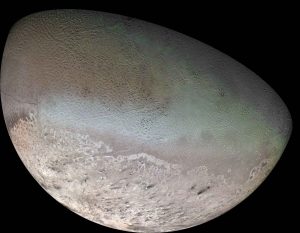
Triton is the largest moon of the planet Neptune with a mean radius of 1,353 km (841 miles) – about 0.78 times the size of our own Moon.
The Voyager 2 spacecraft visited Triton in 1989, showing it has a thin nitrogen atmosphere, with trace amounts of carbon monoxide and methane. Voyager 2 also detected evidence of cryovolcanic activity (ice volcanoes) and geyser-like plumes, some of which were active at the time.
Triton has one of the coldest surfaces of any moon in the Solar System, at around 38 Kelvin, although it it is believed that radioactivity could produce enough heat to maintain a subsurface ocean.
Triton is unusual in that it is the only large moon in our Solar System to have a retrograde orbit, meaning that it orbits Neptune in the opposite direction to the planet’s rotation. This suggests that Triton couldn’t have formed from the same disc of material as Neptune and is likely to be a captured Kuiper Belt object.